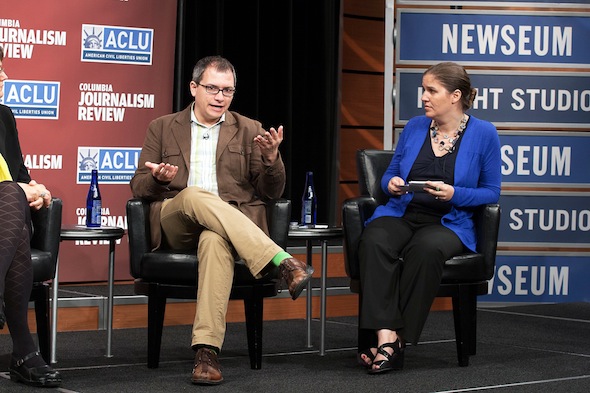
Talking points BuzzFeed’s Chris Geidner, left, CJR columnist and panel moderator, Jennifer Vanasco. (Bob Blanken)
On June 12, two weeks before the Supreme Court, in separate rulings, struck down parts of the Defense of Marriage Act and California’s Proposition 8, CJR convened a panel to discuss coverage of same-sex marriage. “We Now Pronounce You . . . ” was hosted by the Newseum in Washington, DC, and sponsored by the ACLU.
Moderated by CJR’s Minority Reports columnist, Jennifer Vanasco, the panel included E J Graff, the author of the book What Is Marriage For?; Steven Petrow, a New York Times columnist and former president of the National Lesbian and Gay Journalists Association; David Fontana, an associate law professor at George Washington University; and Chris Geidner, a senior political and legal reporter at BuzzFeed.
The panelists speculated on what the then-unknown outcomes of those cases might be (both a section of DOMA and all of Prop 8 were ultimately ruled unconstitutional), but the bulk of the conversation was devoted to questions about how the media should cover the issue, and the relationship between media coverage and public opinion. The following quotes are highlights of the discussion, which can be viewed in full here.
The significance of labels
Panelists spent a decent chunk of time discussing different ways to refer to two men or two women getting married.
“Whenever I hear it called ‘gay marriage,’ I just imagine people thinking only of gay men,” said Graff. “That absolutely drives me crazy, especially since lesbians out-marry men, like two to one.” Indeed, while the numbers vary by state, a 2011 study by Lee Badgett and Jody Herman of the Williams Institute found that, in the eight states that provided them data by gender, 62 percent of same-sex couples who sought legal recognition were married women.
While they didn’t unanimously agree on an alternative to “gay marriage,” the panelists largely agreed with Graff’s critique that the phrase contains too strong of a gender implication. Yet, as Petrow pointed out, a Google search for “gay marriage” returns far more results than a search for “same-sex” marriage. He partly blames the media for not agreeing to use a more neutral term sooner. “I think if we look at ‘global warming’ versus ‘climate change’ and the kind of difference that might have made to our discourse. . . . I think it would have made a big difference, too, had we been more successful in adopting a different language around this,” he said.
“When you look back to the ’60s,” he added, “it was ‘interracial marriage.’ Now those are considered ‘marriages.’ I’m sure we’ll be at that point, but we’re not there yet.”
As Graff observed, this kind of shift is the reason “traditional marriage” is a useless term. “What we tend to call ‘traditional marriage’ now is the 1950s marriage,” she said, “but the 1950s marriage was, in fact, a radical shift from just 100 years before.”
A sea change
Throughout the discussion, the panelists expressed a sense of wonder at how quickly, and drastically, popular opinion of same-sex marriage has shifted. A CBS News poll published in March found that 53 percent of Americans believe that same-sex marriage should be legal, whereas only 39 percent think it should be illegal. According to the same poll, 33 percent of those who think it should be legal “once held the opposite view.”
Petrow recalled that, “As late as the early ’70s, you had major newspapers like the [New York] Times using ‘invert’ and ‘pervert’ ” to refer to gays and lesbians.
Graff placed the latest dramatic shift in public opinion in the late 2000s: “Something happened, and it seemed as if the whole country went, ‘Eh, why would anybody be against it?’ Like, overnight,” she said. “And the news media at pretty much every level was part of that shift.”
David Fontana, of George Washington University, noted a shift from moral logic being employed by opponents of same-sex marriage to its use by proponents. “Marriage equality is a claim about what’s right and what’s wrong,” he said. “In 1996, when Congress passed [doma], it said, explicitly, that this is meant as moral condemnation. If you watched the oral arguments in the Supreme Court in March, the lawyer defending [DOMA]–he’s defending it because we need equality in federal law, because the sociological evidence is still unresolved.”
Embarrassed opponents
The shift toward overwhelming support of same-sex marriage in the US has left those who oppose it reluctant to air their views, panelists said. “There are a lot of people who have changed positions on the issue and are embarrassed about their past statements,” said Chris Geidner of BuzzFeed. He later added that, “We had staff looking for statements from members of Congress supporting DOMA or supporting Prop 8. Literally, I think we found three out of 535 members of Congress.”
Graff, meanwhile, noted that the moralistic tone of the debate has prevented journalists from understanding all sides. “In the media, there is a complete lack of understanding of what the opposition might be,” she said. “I do feel that people are having trouble stepping back and seeing another frame.”
To Petrow, however, the moral weight of the issue is too powerful to resist. He read a statement from Thomas Roberts of msnbc that defends public activism by journalists: “I don’t believe it is biased to support equality. I think it’s an American value.”
Petrow amplified Roberts’ point: “I think with that statement you get someone who, like me, is defining [same-sex marriage] as a civil right and not a political issue.”
Christopher Massie is a CJR contributing editor.
